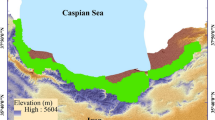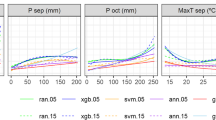Abstract
By analyzing the importance of influencing factors and conducting a comparative study of the effects of different sorting algorithms, a new method is proposed that is suitable for classifying the growth state of a natural Metasequoia glyptostroboides Hu and W.C. Cheng population. We studied 2817 M. glyptostroboides trees over 100 years old and analyzed their growth state by measuring 15 factors from stumpage, site condition, and environmental data. The dimensionality of all factors were reduced using the random forest algorithm, and we classified the remaining factors using the following algorithms: random forest, back-propagation (BP) neural networks, and support vector machine (SVM). The applicability of each sorting algorithm was analyzed. When all the d factors are used for classification and modeling, the model’s overall accuracy, kappa coefficient and test accuracy were 85.5%, 0.739 and 85.8%, respectively. By reducing the dimensionality of the factors using the random forest algorithm, 11 factors most strongly influenced the classifications of the growth state of the Metasequoia population: diameter at breast height, height, crown width, age from stumpage data; longitude, latitude, elevation, slope aspect, gradient and slope position from the site condition data; and the edge of the field from the environmental data. For classifying the Metasequoia population, the random forest algorithm has the highest overall accuracy at 87.2%, which is 3.4 and 2.3% higher than the BP neural networks and SVM algorithms, respectively. The SVM algorithm is superior to the random forest algorithm with respect to classifying the state of mortality. The combination of the random forest and SVM algorithms and their combined information can be used to classify and predict the growth state of this natural M. glyptostroboides population to provide a scientific basis for its effective protection.




Similar content being viewed by others
References
Angus J (2007) Fungal damage recorded in eucalypt plantations during forest health surveys and their management. Australas Plant Pathol 36(3):225–239
Beijma SV, Comber A, Lamb A (2014) Random forest classification of salt marsh vegetation habitats using quad-polar metric airborne SAR, elevation and optical RS data. Remote Sens Environ 149:118–129
Briffa KR (2000) Annual climate variability in the Holocene: interpreting the message of ancient trees. Quatern Sci Rev 19(1–5):87–105
Chen YP, Yun WJ, Zhou X, Peng JH, Li SS, Zhou Y (2017) Classification and extraction of land use information in hilly area based on MESMA and RF classifier. Trans Chin Soc Agric Mach 48(7):136–144
Cutler DR, Edwards TC, Beard KH, Cutler A, Hess KT, Gibson J, Lawler JJ (2007) Random forests for classification in ecology. Ecology 88(11):2783–2792
Edwin KM, Tiffany C, Navdeep SC, Amoah YK, Arthur K, Rana R, Abraham Garth S (2014) Su1304 Is fecal calprotectin really useful for diagnostic decision making in the inpatient setting. Gastroenterology 146(5):S-431
Freeman EA, Moisen GG, Coulston JW, Wilson BT (2015) Random forests and stochastic gradient boosting for predicting tree ca. Can J For Res 46(3):323–339
Fu BJ, Yu DD, Lv N (2017) An indicator system for biodiversity and ecosystem services evaluation in China. Acta Ecol Sin 37(2):341–348
Gao ZL, Yu XX, Yue YJ, Bian Z, Yang BQ, Cao B, Qin YS (2008) Forest health assessment in Songshan nature reserve of Beijing. J Beijing For Univ Z2:127–131
Guo Z, Zang RG (2013) Evaluation index system of endangered levels of the wild plants with tiny population in China. Scientia Silvae Sinicae 49(6):10–17
Guo F, Zhang L, Jin S, Tigabu M, Su Z, Wang W (2016) Modeling anthropogenic fire occurrence in the boreal forest of china using logistic regression and random forests. Forests 7(250):1–14
Hothorn T, Zeileis A (2015) Partykit: a modular toolkit for recursive partitioning in R. JMLR 16(1):3905–3909
Huang MF, Xu C, Cao HY, Huang XS, Yuan FJ, Yin YC, Zhang S, Yin ZF, Kui JX, Luo ZR, Duan XH, Wang HX, Dai CL, Guan RF (2009) Vegetative growth of Eupatorium adenophorum in different habitats. Chin J Trop Crops 30(10):1429–1436
Le XW (2013) Phylogeographic study of a relict plant: Metasequoia glyptostroboides. East China Normal University, Shanghai
Ledo A (2015) Nature and age of neighbours matter: interspecific associations among tree species exist and vary across life stages in tropical forests. PLoS ONE 10(11):e0141387
Ledo A, Cañellas I, Barbeito I, Gordo FJ, Calama RA, Gea-Izquierdo G (2014) Species coexistence in a mixed Mediterranean pine forest: spatio-temporal variability in trade-offs between facilitation and competition. For Ecol Manage 322(3):89–97
Leo B (2001) Random forests. Mach Learn 45(1):5–32
Li YY (2006) Phylogenetic position and recovery assessment of Metasequoia glyptostroboides. East China Normal University, Shanghai
Li XH (2013) Using “random forest” for classification and regression. Chin Bull Entomol 50(4):1190–1197
Li YY, Chen XY, Zhang X, Wu TY, Lu HP, Cai YW (2005) Genetic differences between wild and artificial populations of Metasequoia glyptostroboides: implications for species recovery. Conserv Biol 19(1):224–231
Li CM, Weng SF, Pang RJ (2010) Tree health assessment of fourteen landscape tree species in Guangzhou. J Northwest For Univ 25(2):203–207
Li JH, Li YY, Zhao LM, Zuo LX (2012) Effects of site conditions and tree age on Robinia pseudoacacia and Populus simonii leaf hydraulic traits and drought resistance. Chin J Appl Ecol 23(9):78–84
Lin Y, Ai XR, Yao L, Guo QJ, Zhang MX, Chen J (2017) Population structure and dynamics of Metasequoia glyptostroboides parent trees. Chin J Ecol 36(6):1531–1538
Liu SX, Zou JP et al (2003) Scientific survey of Xingdoushan nature reserve Hubei. Hubei Science & Technology Press, Wuhan
Liu M, Feng Z, Zhang Z, Ma C, Wang M, Lian BL, Sun R, Zhang L (2017a) Development and evaluation of height diameter at breast models for native Chinese Metasequoia. PLoS ONE 12(8):e0182170
Liu S, Jiang QG, Ma Y, Xiao Y, Li YH, Cui C (2017b) Object-oriented wetland classification based on hybrid feature selection method combining with relief F, multi-objective genetic algorithm and random forest. Trans Chin Soc Agric Mach 48(1):119–127
Luo M (2017) Ovts reason of decline and its protection and rejuvenation measures. Xiandai Hortic 2:232–233
Ma JL, Xuan LF, Liu DJ (1995) Site quality estimation for natural Korean pine forest using total height and diameter of dominant tree. J Northeast For Univ 3(2):20–27
Ma LH, Wu PT, Wang YK (2012) Spatial pattern of root systems of dense jujube plantation with jujube age in the semiarid loess hilly region of China. Chin J Plant Ecol 36(4):292–301
Ma Y, Jiang QG, Meng ZG, Li YH, Wang D, Liu YX (2016) Classification of land use in farming area based on random forest algorithm. Trans Chin Soc Agric Mach 47(1):297–303
O’Laughlin J (2003) Inventory-based forest health indicators: implications for national forest management. J Forest 101(2):11–17
Tang CQ, Yang Y, Ohsawa M, Momohara A, Hara M, Cheng S, Fan S (2011) Population structure of relict Metasequoia glyptostroboides and its habitat fragmentation and degradation in south-central China. Biol Cons 144(1):279–289
Tóth J, Héthelyi ÉB, Háznagyradnai E, Böszörményi A, Czigle S (2016) Living fossil volatile compounds analysis using SPME GC–MS: examples of Sequoia, Sequoiadendron and Metasequoia. Planta Med 81(S01):S1–S381
Wang XQ, Ma LY, Guo BX, Ge JW, Fan SH (2004) The conservation of Metasequoia glyptostroboides and its current problems in China. Biodivers Sci 12(3):377–385
Wang YX, Dai WS, Bai SB, Jiang F, Jin ZD (2006) Improved survey method of ancient and famous trees. J Zhejiang A&F Univ 23(5):549–553
Wei ZS, Han K, Yang JY, Shen HB, Yu DJ (2016) Protein–protein interaction sites prediction by ensembling SVM and sample-weighted random forests. Neurocomputing 193(C):201–212
Wu QY, Chen LH, Li XF, Wang P, Bian XC (2011) Prediction of forest ecosystem health based on BP neural network. Bull Soil Water Conserv 31(2):150–154
Yang Y, Liu B (2011) Who is the “living fossil” Metasequoia named person. Fossils 3:44–45
Yang D, Pan S, Tyree MT (2016) The impact of xylem cavitation on water potential isotherms measured by the pressure chamber technique in Metasequoia glyptostroboides Hu & W.C. Cheng. J Exp Bot 67(15):4571–4580
Yuan F, Zhang XY, Liang J (2012) Assessment indicators system of forest ecosystem health based on the harmful disturbance. Acta Ecol Sin 32(3):964–973
Zhang L, Wang LL, Zhang XD, Liu SR, Sun PS, Wang TL (2014) The basic principle of random forest and its applications in ecology: a case study of Pinus yunnanensis. Acta Ecol Sin 34(3):650–659
Zhang H, Guo W, Yu M, Wang GG, Wu T (2017) Latitudinal patterns of leaf n, p stoichiometry and nutrient resorption of Metasequoia glyptostroboides along the eastern coastline of China. Sci Total Environ 618:1–6
Zhong J (2000) The Ministry of Construction issued the “measures for the protection and management of ancient trees and famous trees”. Urban Plan News Rep 19:6
Zhu Z, Woodcock CE, Rogan J, Kellndorfer J (2012) Assessment of spectral, polar metric, temporal, and spatial dimensions for urban and peri-urban land cover classification using land sat and SAR data. Remote Sens Environ 117(1):72–82
Zhu Y, Liu ZG, Jin GZ (2013) Health assessment of individual trees in natural Larix gmelinii forest in Great Xing’ an mountains of China. Chin J Appl Ecol 24(5):1320–1328
Acknowledgements
We thank Professor Zhixiang Zhang from the School of Nature Conservation, Beijing Forest University and Lecturer Gang Liu from the College of Horticulture and Forestry Sciences, Huazhong Agricultural University, who provided help with survey instruments.
Author information
Authors and Affiliations
Corresponding author
Additional information
Project funding: This work was supported by Study on Spatial Environmental Effect Model and Forestation Decision Support System for Forest Vegetation in Beijing (6161001).
The online version is available at http://www.springerlink.com
Corresponding editor: Chai Ruihai.
Rights and permissions
About this article
Cite this article
Liu, M., Feng, Z., Ma, C. et al. Influencing factors and growth state classification of a natural Metasequoia population. J. For. Res. 30, 337–345 (2019). https://doi.org/10.1007/s11676-018-0752-0
Received:
Accepted:
Published:
Issue Date:
DOI: https://doi.org/10.1007/s11676-018-0752-0




